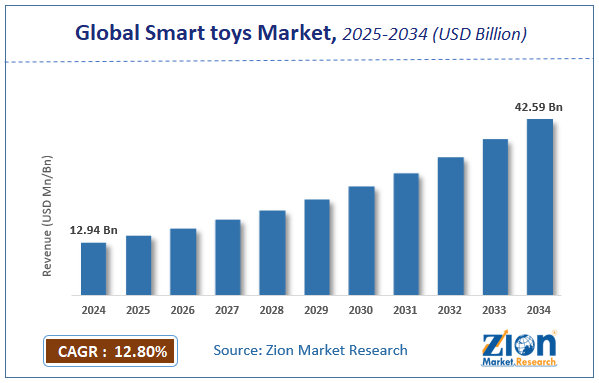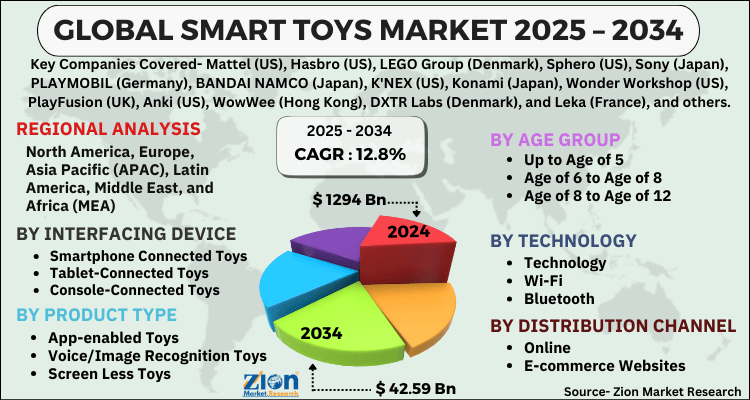Global Smart toys Market Size, Share, Growth Analysis Report - Forecast 2034

Smart toys Market By Interfacing device (Smartphone Connected Toys, Tablet-Connected Toys, Console-Connected Toys), By Product Type (App-enabled Toys, Voice/Image Recognition Toys, Screen Less Toys, Toys-to-Life, Health Tracking Toys, Others (Wearable, Puzzle Toys, etc.)), Age Group (Up to Age of 5, Age of 6 to Age of 8, Age of 8 to Age of 12, Age of 13 to Age of 18, Above Age of 18), By Price (Low, Medium, High), Technology (Technology, Wi-Fi, Bluetooth, Others (RFID, NFC, etc.)), Distribution Channel (Online, E-commerce Websites, Company Owned Websites, Offline, Hypermarket and Supermarkets, Specialty Stores, Other Retail Based Stores), and By Region: Global and Regional Industry Overview, Market Intelligence, Comprehensive Analysis, Historical Data, and Forecasts 2025 - 2034
| Market Size in 2024 | Market Forecast in 2034 | CAGR (in %) | Base Year |
|---|---|---|---|
| USD 12.94 Billion | USD 42.59 Billion | 12.8% | 2024 |
Industry Perspective:
The global smart toys market was worth around USD 12,525.1 million in 2021 and is estimated to grow to about USD 33640.6 million by 2028, with a compound annual growth rate (CAGR) of approximately 17.9 percent over the forecast period. The report analyzes the smart toys market’s drivers, restraints/challenges, and the effect they have on the demands during the projection period. In addition, the report explores emerging opportunities in the smart toys market.
Smart Toys Market: Overview
Smart toys are toys that are connected to smart devices or the internet and provider better functional features. These smart toys are also equipped with technologies like artificial intelligence and the internet of things (IoT). They also use speech synthesizers and other speech related software to make the experience more interactive with kids.
Smart toys have also been highly popular in advanced schools as they have been used as learning aids for children in their developmental ages. Increasing adoption of Science, Technology, Engineering, and Mathematics in the educational curricula is also expected to favor smart toys market potential.
Increasing technological proliferation and rising disposable income of the general population are also expected to favor the smart toys market potential through 2028.
Key Insights
- As per the analysis shared by our research analyst, the global smart toys market is estimated to grow annually at a CAGR of around 12.8% over the forecast period (2025-2034).
- Regarding revenue, the global smart toys market size was valued at around USD 12.94 Billion in 2024 and is projected to reach USD 42.59 Billion by 2034.
- The smart toys market is projected to grow at a significant rate due to increasing integration of ai and iot in children's educational toys.
- Based on Interfacing device, the Smartphone Connected Toys segment is expected to lead the global market.
- On the basis of Product Type, the App-enabled Toys segment is growing at a high rate and will continue to dominate the global market.
- Based on the Age Group, the Up to Age of 5 segment is projected to swipe the largest market share.
- By Technology, the Technology segment is expected to dominate the global market.
- In terms of Distribution Channel, the Online segment is anticipated to command the largest market share.
- Based on region, North America is predicted to dominate the global market during the forecast period.
Smart toys Market: Growth Drivers
Increasing Working Population
The working women population has substantially increased over the past few years and this trend is expected to prominently drive the smart toys market potential over the forecast period. This working class population will further bolster the demand for smart toys as parents seek advanced toys that they can administer to their kids in their absence. The rising popularity of smart technology is also expected to boost the smart toys market growth over the forecast period. Increasing disposable income is also projected to positively influence the smart toys market potential through 2028.
Smart toys Market: Opportunities
Increasing Demand for Remote Learning
Smart toys are used for educational purposes and are also being recommended by teaching professionals, especially for the kids that are in their developmental years. Increasing adoption of smart toys in the education sector with the rising popularity of remote learning is expected to be a major trend that will favor smart toys market growth. Smart toys companies are expected to focus on this trend to boost their sale generation potential.
Global Smart toys Market: Segmentation
Smart toys Market: Segmentation Analysis
The global smart toys market is segmented based on Interfacing device, Product Type, Age Group, Technology, Distribution Channel, and region.
Based on Interfacing device, the global smart toys market is divided into Smartphone Connected Toys, Tablet-Connected Toys, Console-Connected Toys.
On the basis of Product Type, the global smart toys market is bifurcated into App-enabled Toys, Voice/Image Recognition Toys, Screen Less Toys, Toys-to-Life, Health Tracking Toys, Others (Wearable, Puzzle Toys, etc.).
By Age Group, the global smart toys market is split into Up to Age of 5, Age of 6 to Age of 8, Age of 8 to Age of 12, Age of 13 to Age of 18, Above Age of 18), By Price (Low, Medium, High.
In terms of Technology, the global smart toys market is categorized into Technology, Wi-Fi, Bluetooth, Others (RFID, NFC, etc.).
By Distribution Channel, the global Smart toys market is divided into Online, E-commerce Websites, Company Owned Websites, Offline, Hypermarket and Supermarkets, Specialty Stores, Other Retail Based Stores.
Smart toys Market: Report Scope
| Report Attributes | Report Details |
|---|---|
| Report Name | Smart toys Market |
| Market Size in 2024 | USD 12.94 Billion |
| Market Forecast in 2034 | USD 42.59 Billion |
| Growth Rate | CAGR of 12.8% |
| Number of Pages | 165 |
| Key Companies Covered | Mattel (US), Hasbro (US), LEGO Group (Denmark), Sphero (US), Sony (Japan), PLAYMOBIL (Germany), BANDAI NAMCO (Japan), K'NEX (US), Konami (Japan), Wonder Workshop (US), PlayFusion (UK), Anki (US), WowWee (Hong Kong), DXTR Labs (Denmark), and Leka (France), and others. |
| Segments Covered | By Interfacing device, By Product Type, By Age Group, By Technology, By Distribution Channel, and By Region |
| Regions Covered | North America, Europe, Asia Pacific (APAC), Latin America, The Middle East and Africa (MEA) |
| Base Year | 2024 |
| Historical Year | 2020 to 2024 |
| Forecast Year | 2025 to 2034 |
| Customization Scope | Avail customized purchase options to meet your exact research needs. Request For Customization |
Recent Developments
- In January 2020 – PlayShifu a leading name in AR based STEM toys announced the launch of its new product portfolio. These include the existing Shifu Tacto, Shifu Plugo, and a completely new Shifu Orboot.
Regional Landscape
North America region leads the global smart toys market in terms of revenue and volume share and is anticipated to maintain this dominant position over the forecast period. The presence of key smart toys companies, increasing disposable income, and the presence of a busy lifestyle are expected to be the major trends influencing growth in this region over the forecast period. The United States and Canada are projected to be the most lucrative markets for smart toys through 2028 in this region. These nations have high spending potential and a high working population which makes them a lucrative market for smart toys.
Smart toys Market: Competitive Analysis
The report provides a company market share analysis to give a broader overview of the key market players. In addition, the report also covers key strategic developments of the market, including acquisitions & mergers, new product launches, agreements, partnerships, collaborations & joint ventures, research & development, and regional expansion of major participants involved in the smart toys market on a global and regional basis.
The global smart toys market is dominated by players like:
- Mattel (US)
- Hasbro (US)
- LEGO Group (Denmark)
- Sphero (US)
- Sony (Japan)
- PLAYMOBIL (Germany)
- BANDAI NAMCO (Japan)
- K'NEX (US)
- Konami (Japan)
- Wonder Workshop (US)
- PlayFusion (UK)
- Anki (US)
- WowWee (Hong Kong)
- DXTR Labs (Denmark)
- and Leka (France)
The global smart toys market is segmented as follows;
By Interfacing device
- Smartphone Connected Toys
- Tablet-Connected Toys
- Console-Connected Toys
By Product Type
- App-enabled Toys
- Voice/Image Recognition Toys
- Screen Less Toys
- Toys-to-Life
- Health Tracking Toys
- Others (Wearable
- Puzzle Toys
- etc.)
By Age Group
- Up to Age of 5
- Age of 6 to Age of 8
- Age of 8 to Age of 12
- Age of 13 to Age of 18
- Above Age of 18)
- By Price (Low
- Medium
- High
By Technology
- Technology
- Wi-Fi
- Bluetooth
- Others (RFID
- NFC
- etc.)
By Distribution Channel
- Online
- E-commerce Websites
- Company Owned Websites
- Offline
- Hypermarket and Supermarkets
- Specialty Stores
- Other Retail Based Stores
By Region
- North America
- The U.S.
- Canada
- Mexico
- Europe
- France
- The UK
- Spain
- Germany
- Italy
- Rest of Europe
- Asia Pacific
- China
- Japan
- India
- Australia
- South Korea
- Rest of Asia Pacific
- The Middle East & Africa
- Saudi Arabia
- UAE
- Egypt
- Kuwait
- South Africa
- Rest of the Middle East & Africa
- Latin America
- Brazil
- Argentina
- Rest of Latin America
Table Of Content
Methodology
FrequentlyAsked Questions
The global smart toys market is expected to grow due to increasing consumer preference for interactive and educational toys, advancements in ai and iot, and rising digitalization of children's entertainment.
According to a study, the global smart toys market size was worth around USD 12.94 Billion in 2024 and is expected to reach USD 42.59 Billion by 2034.
The global smart toys market is expected to grow at a CAGR of 12.8% during the forecast period.
North America is expected to dominate the smart toys market over the forecast period.
Leading players in the global smart toys market include Mattel (US), Hasbro (US), LEGO Group (Denmark), Sphero (US), Sony (Japan), PLAYMOBIL (Germany), BANDAI NAMCO (Japan), K'NEX (US), Konami (Japan), Wonder Workshop (US), PlayFusion (UK), Anki (US), WowWee (Hong Kong), DXTR Labs (Denmark), and Leka (France), among others.
The report explores crucial aspects of the smart toys market, including a detailed discussion of existing growth factors and restraints, while also examining future growth opportunities and challenges that impact the market.
RelatedNews
HappyClients
Zion Market Research
Tel: +1 (302) 444-0166
USA/Canada Toll Free No.+1 (855) 465-4651
3rd Floor,
Mrunal Paradise, Opp Maharaja Hotel,
Pimple Gurav, Pune 411061,
Maharashtra, India
Phone No +91 7768 006 007, +91 7768 006 008
US OFFICE NO +1 (302) 444-0166
US/CAN TOLL FREE +1 (855) 465-4651
Email: sales@zionmarketresearch.com
We have secured system to process your transaction.
Our support available to help you 24 hours a day, five days a week.
Monday - Friday: 9AM - 6PM
Saturday - Sunday: Closed






